PART 2
SINCE 2009 CAPE TOWN'S CHACMA BABOONS ARE

Young baboons sit with a female baboon, showing signs of trauma from the treatment they witnessed after the introduction of bullwhips, one of the recommendations made in a presentation by Dr Justin O'Riain, head of BRU at a baboon expert workshop in July (see below), raising a public outcry and objections from the SPCA when implemented by the interim service provider.
On the first day whips were introduced in September 2009, an eyewitness observed a monitor lash out towards the male's face, causing him to flee up a roof and not come down. Days after the incident, the youngsters were heard on different occasions emitting an alarm cry when someone came into sight.
Withdrawn,
whips continued to be used with the Smitswinkel troop in
Simonstown, monitored by volunteers organized by Simonstown residents
during a time when funding had run out and their calls for the
authorities to intervene were growing.
In
December, it was announced whips were introduced again for the other
troops as well as plastic pipes to bang on the ground. Then chairperson
of the BMT, Natasha Wilson of CapeNature, who was closely involved in a
number of the controversial decisions including the contract awarding
process, defended their use saying in a newspaper article that it takes
place under "strict control".
However, monitors are often alone with
the baboons and there is concern that more incidents could occur, leaving the baboons traumatised or even changing their nature if placed in a stressful situation on a
daily basis, particularly if males feel their young threatened.
Rather than cracking the whip as a supposed noise aversion technique, baboons are effectively controlled by baboon vocalizations, shouts, whistles as demonstrated by Baboon Matters over many years.

Baboon Matters' monitor walks with troop members, escorting them out of a village to forage in the hills. Baboons choose sleep sites close to water and in tall trees such as pines or on rocky outcrops. Baboon Matters' monitors predominantly used shouts, whistles and baboon noises to herd the baboons.
Under new management bullwhips and horsewhips were introduced to herd the animals, supposedly for noise aversion but with the real possibility of baboons actually being hit, given that monitors are not supervised at all times, also sending a wrong message to residents that whips can be used to hit the baboons. Most of the baboons in a troop consist of the much smaller females and young that are sensitive and easily traumatised.
The service provider uses a method of "holding the line" whereby usually 4 monitors stand in a line in order to prevent the baboon from breaking through it. However, the line is quickly broken if one baboon breaks through, and then another requiring monitors go after the baboons to attempt to prevent them raiding. It does not work in areas where home ranges are very close to urban areas, separated by only a street. It is essential for monitors to be able to round the baboons up when they are scattered using vocalisations - whistles, baboon sounds, shouts.
It is of note that baboons weigh the same as dogs and puppies, with an adult male's weight of around 30-40 kgs and a female half that, and youngsters much less. (Horses and bulls reach weights of over 1000-1500 kgs respectively.) Using whips around baboons - or intimidating them with sticks or stones - is more in line with "baboon baiting".
Given that most of the new roleplayers had little or no experience in baboon monitoring, Baboon Matters' made themselves available to help train the monitors but this offer was not taken up.
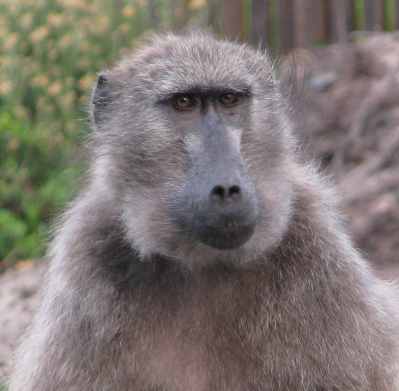
Her cheek pouches full, female baboon eats some bread obtained from a carelessly secured garbage bin. Bread or high calorie foods such as pasta are some of the baboons' favourite foods gained from unsecured residential properties. Half a loaf supplies the energy needs gained from hours of natural foraging.
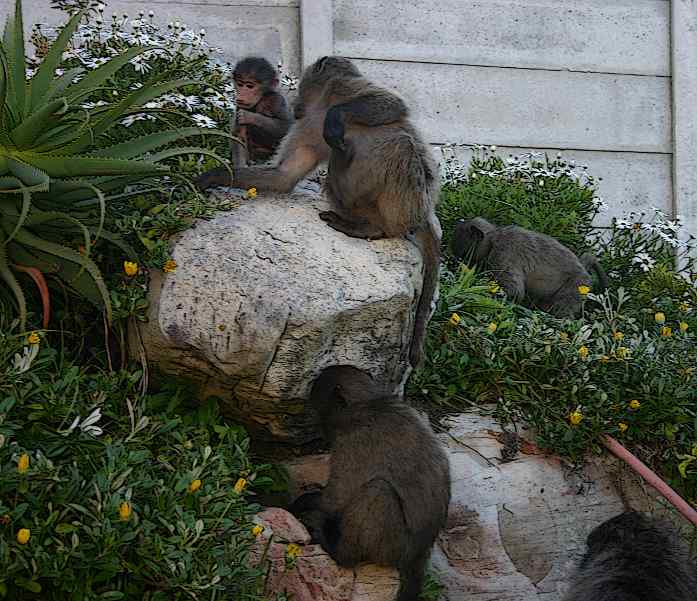
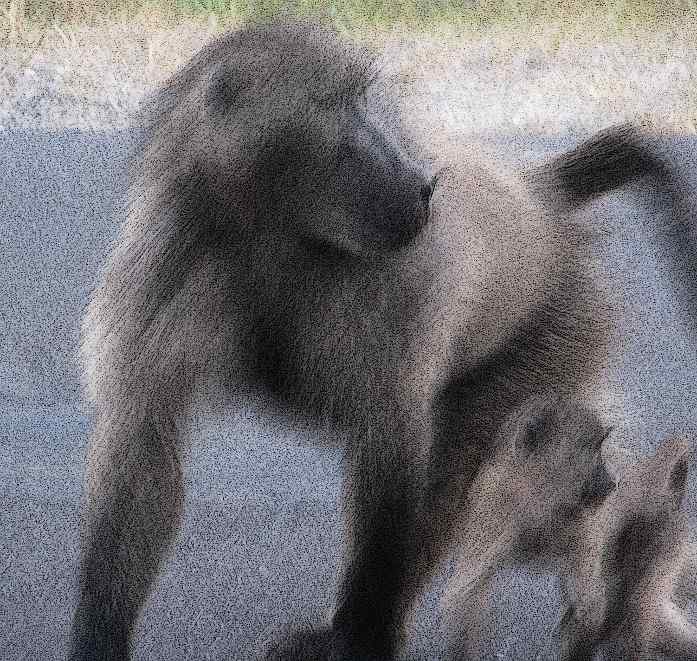
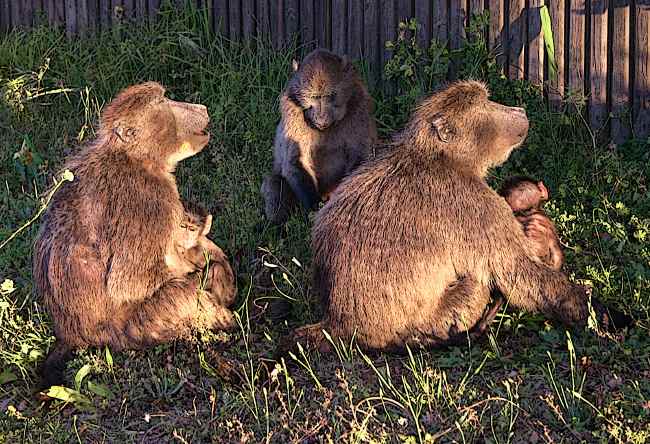
However, reducing numbers of the already threatened Peninsula baboons is already underway by means of a controversial new protocol biased against baboons' natural behaviour. It uses input by a baboon research unit consulted by CapeNature, which has received criticism from other scientists, primatologists and experts.
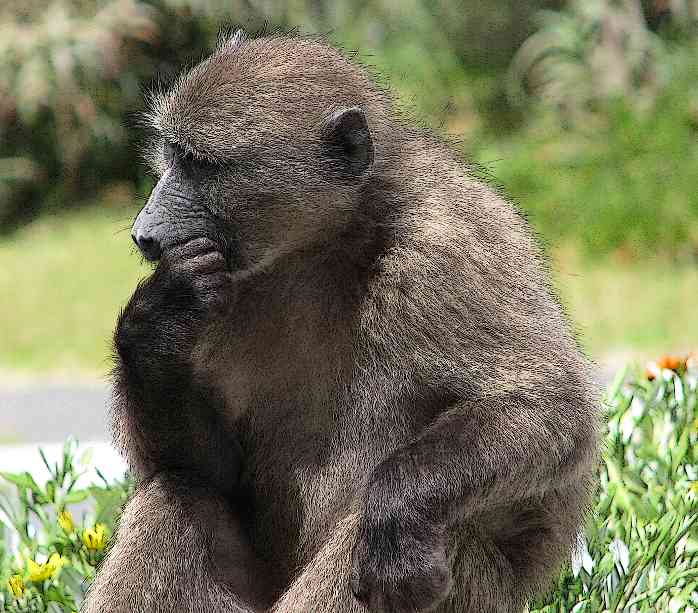
A
young baboon appears lost in thought. Many people, both locally and
internationally became extremely
concerned about the Peninsula baboons, following management changes and
strategies made since July 2009, backed up with scientific
recommendations criticized by other independent scientists,
primatologists and experts.
Where
necessary revised strategies are needed that take into
consideration both residents' and baboons' interests because some of
the current strategies, including and specifically the protocol, are
decidedly biased against baboons.
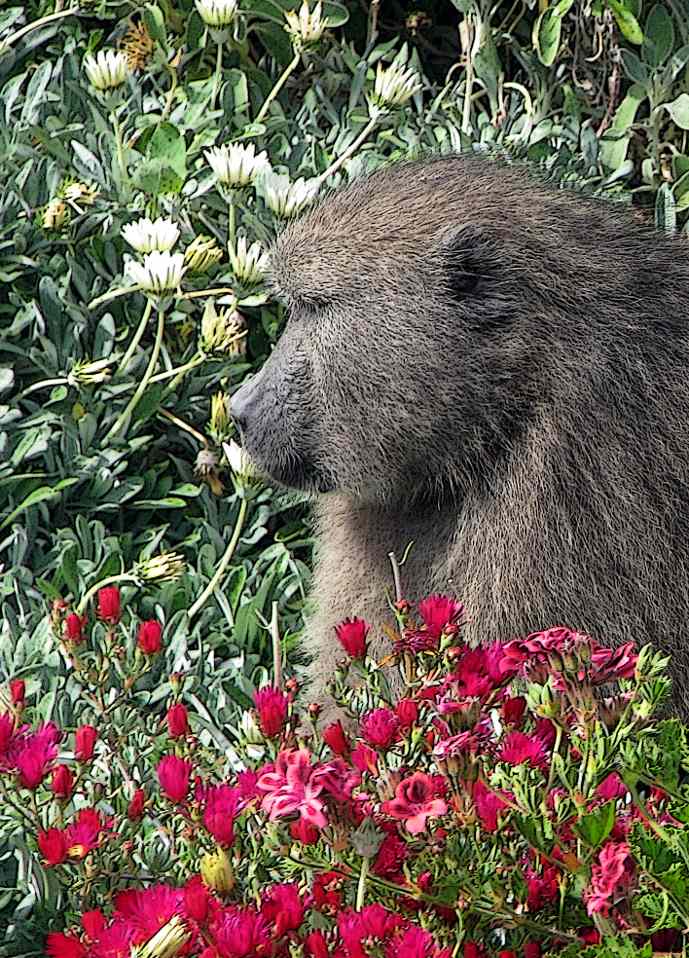
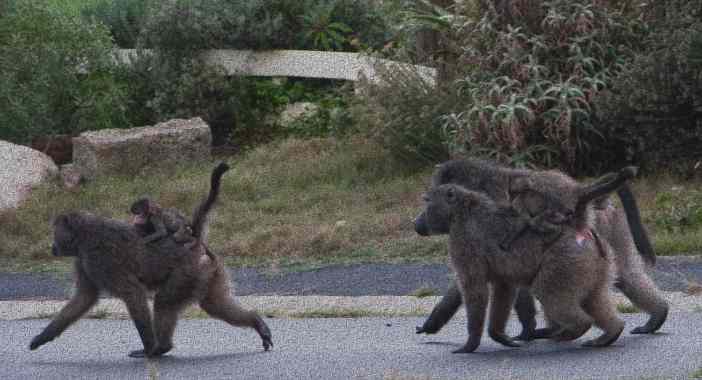
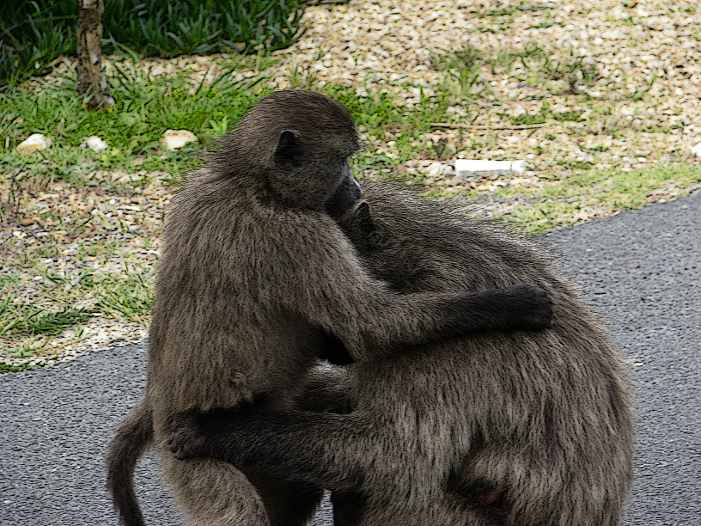
In 2009 baboon management was in a state of crisis, with some decisions made following a baboon expert workshop in July that adversely affect the baboons both in the short and long term.
Rather than using only one or two sources of scientific advice, input from independent scientists, primatologists and baboon experts needs to be heeded to ensure decisions are made in the best interests of the increasingly endangered Peninsula baboons.
While on the one hand the baboons have been praised as a "major asset of Cape Town" , not "highly dangerous to man" and "a popular tourist attraction" by decision makers, the strategies adopted threaten their well-being in the short and long term. With such a small population to begin with, there is no room for error and experimentation.
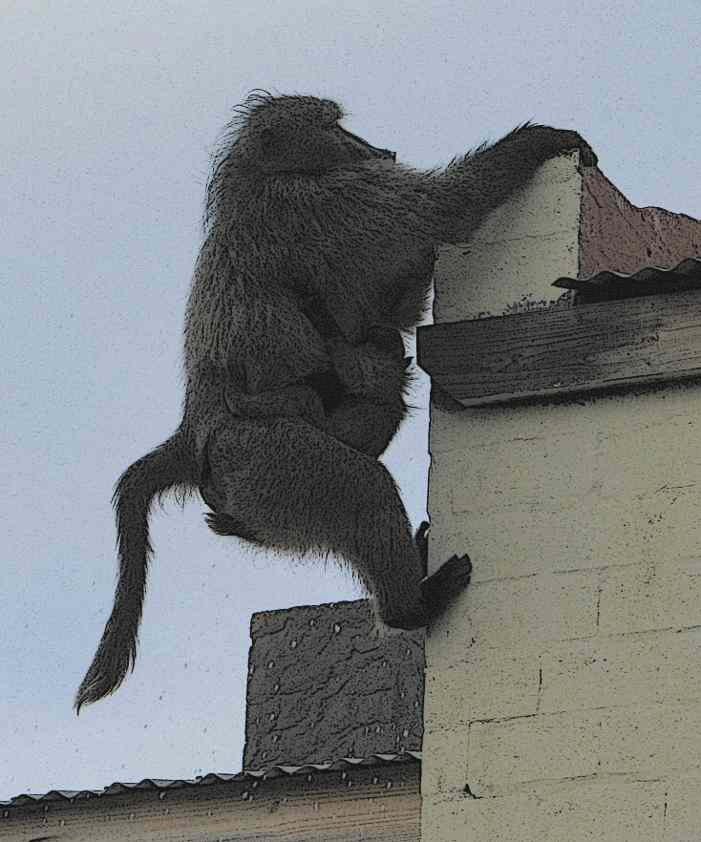
Male baboon climbs down from roof with
youngster after it was nervous about climbing down. Males are
vital for the troop to function in a free-ranging situation,
including for its protection of young and females.
A City tender that closed
December 21, 2009, asked for quotes to remove, relocate and/or euthanize
a quantity of 4 "dispersing males" per month, showing that culling was still seen as part of the management strategy.
The protocol is heavily biased against the baboons and in effect attempts to override their protected status and its implementation has been criticized by many concerned people around the world.
One petition set up by Baboon Matters Trust supported the translocation off the Peninsula of the baboons in a bid to save their lives, translocation being seen as preferable to culling.
The question has been asked why should the baboons be forced to leave the Peninsula when the protocol is flawed and overtly prejudiced against the current baboon population?
As the "action plan for
dispersing males and/or repeat raiders" potentially targets far
more than dispersing males, with any baboon potentially a
repeat raider given available food, rather than removing the
indigenous Peninsula baboons in a desperate measure to save their lives, it is the protocol that needs to
go.
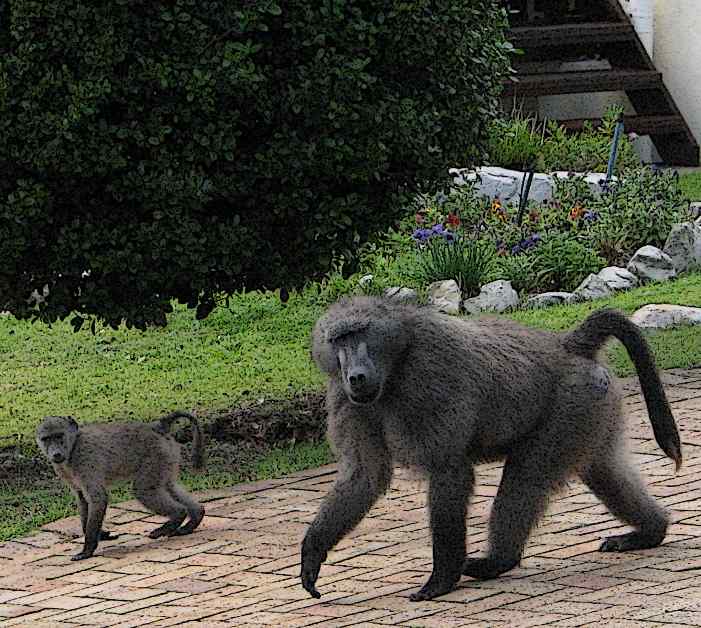
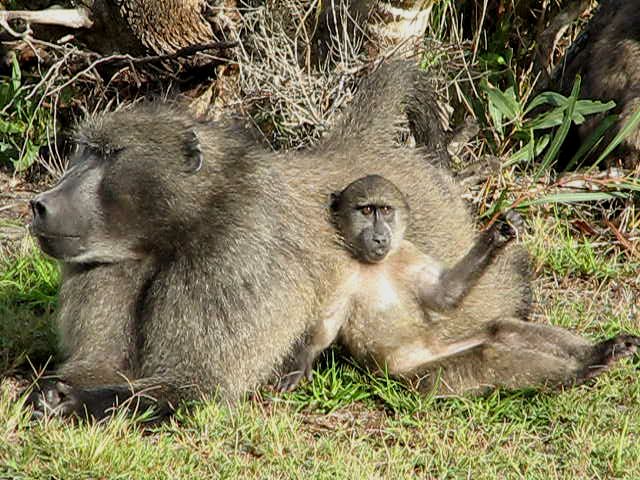
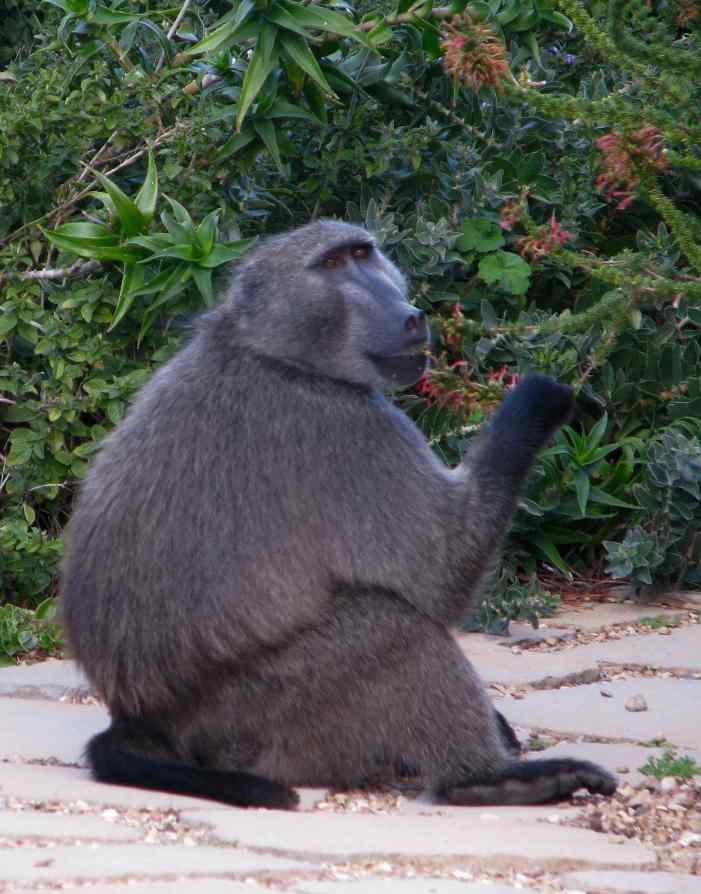
Even while ostensibly protected by law on the Peninsula for the last decade, the baboons have continued to be shot at and injured, with few prosecutions occurring to act as a deterrent for such behaviour. Residents also endanger the safety of neighbours and pets by shooting in a residential area. In 2009 a hotline was set up to report illegal feeding and hurting of baboons. Unfortunately those hurting and/or wanting baboons removed from the area, also began making hoax calls against those they perceived as tolerating the baboons.
Some residents excuse their pointing of weapons by saying their guns are not loaded and it makes the baboons run away - yet the number of baboons riddled with pellets shows that these guns are being used.
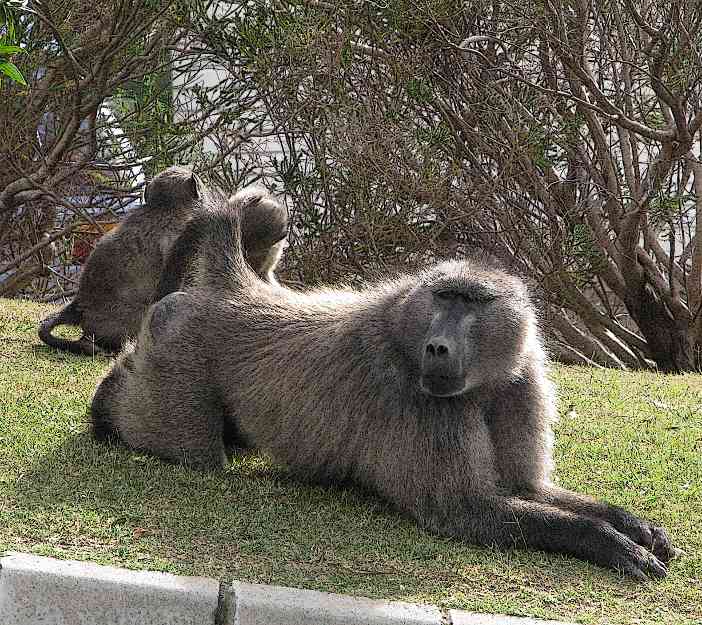
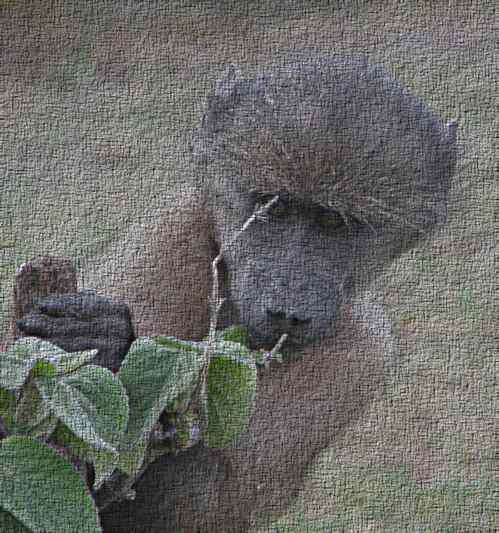
Young baboon peers at something while climbing a bush. They are curious, playful and interactive. When small, they are of intense interest to other troop members who lavish attention on them.
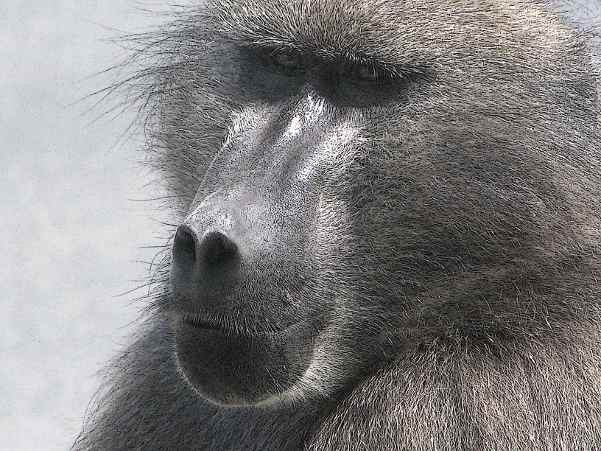
Adult
male baboon. Baboons should always be treated with respect, as with
any wild animal and should not be teased in any way. For primates, this includes observing rules such as
not staring directly into their eyes which can be seen by them as a sign of
aggressive threat behaviour.
According
to
Dr Justin O'Riain, involved in the preparation and endorsement of
the recent protocol, the most damaging myth about baboons is that they
are "highly dangerous" to man. Yet after fear-mongering and
suspect complaints about baboons posing an potential increased danger
to safety
of residents earlier in 2009, some residents made calls for
authorities to take action against them. (There has long been a lobby
in certain areas that wish the baboons removed.)
In
July 2009 controversial
management changes were made amidst allegations of a flawed process and
in August a far-reaching protocol was adopted which currently threatens the
Peninsula baboons' existence as
individuals and as a whole.
Similar allegations of increased aggression
are again being
heard in relation to 2010 tourism including in an article syndicated
worldwide quoting Dr O'Riain expressing concern about the World Cup
influx of tourists and that tourists who stop the car will be raided -
it failed to mention that locking the doors and closing windows would
prevent that happening.
It
also quoted a resident who had earlier in the year written to
CapeNature asking if baboons could be shot "in self-defense" saying they could
not be controlled with the recommended jet of hose water. This may have been her subjective experience but is not true of other residents' experiences. She was quoted then in the media as saying "one suggestion is to relocate or cull the more aggressive males" .
The
difference since her first allegations is now the culling protocol is
in place which places the baboons in greater danger than ever,
particularly if the City decides to enforce its mandate of safety and
security with regard to the allegations made against the baboons.
Unfortunately, the media can play a role in stirring
up sentiment against baboons by printing accounts which may be negatively biased or less than accurate reporting, omitting the role of lack of human responsibility.

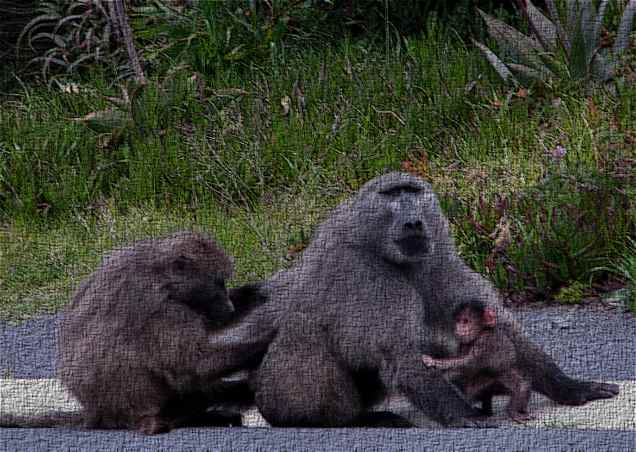
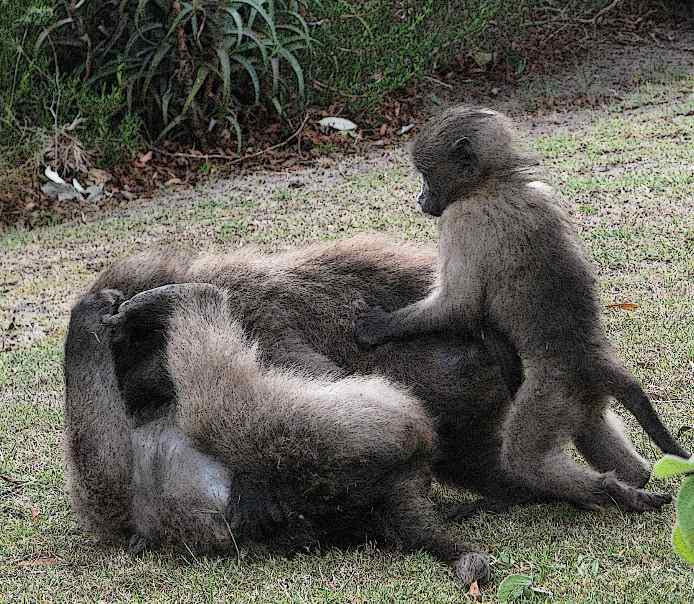
Young
baboon tries to join in the rough and tumble of two older
juveniles. Many residents and tourists enjoy watching the
entertaining baboons. However, those opposing baboon presence can be
extremely vocal, even projecting their anger and animosity towards
baboons onto those who tolerate them or are working with them such as
the monitors.

Juvenile baboon. Male baboons are fully mature at around the age of approximately 7 or 8, females around 6 years.
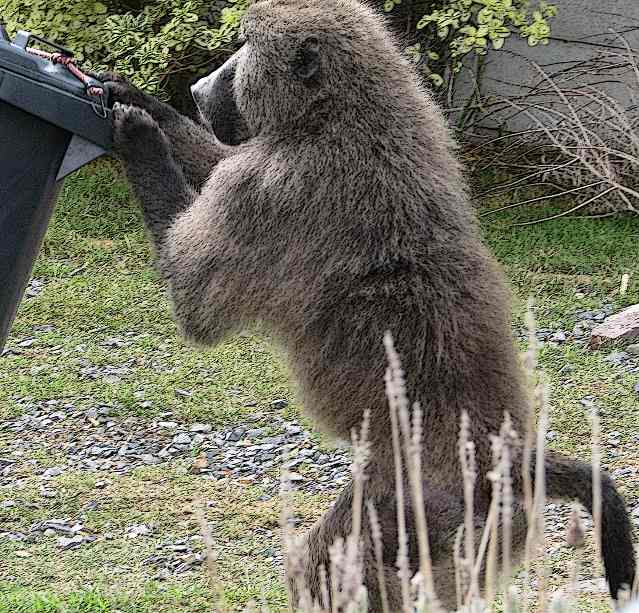
Adult male baboon tries a bin. Baboons are opportunistic feeders and will eat available food. Residents who consistently take effective precautions have lived for many years without a single incursion into home or bin. Those who fail to secure or even refuse to secure their properties may become frustrated, even taking retaliatory measures against the animals - which does nothing to solve the problem.
Now a protocol has been adopted which would
allow animals considered "repeat raiders" to be killed. This in effect does away with their "protected" status, giving rise to questions about its own legality. Given unsecured properties, baboons
from small to large will eat available food, showing how unfairly
biased the protocol is against them.
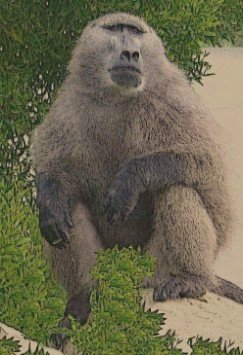
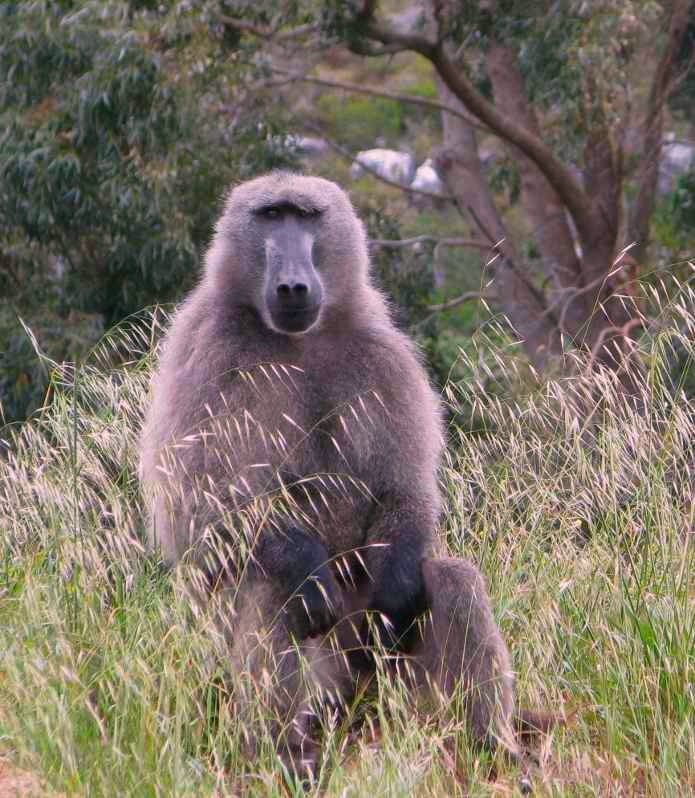
Two troop leaders sit on a rock. The chacma baboon is called "papio ursinus" - i.e. baboon resembling a bear. (Although adult males weigh up to 30-40 kg, with females smaller at 15-20 kg and juveniles much smaller, the larger males in particular may resemble bears in appearance.)
While they may be opportunistic feeders like bears, baboons are not bears, neither do they predate on man, instead often exhibiting remarkable control in dealing with provocation by humans and dogs. Some residents continue to seek to portray them as a great threat to human safety in order to force or justify authorities taking drastic action such as culling.
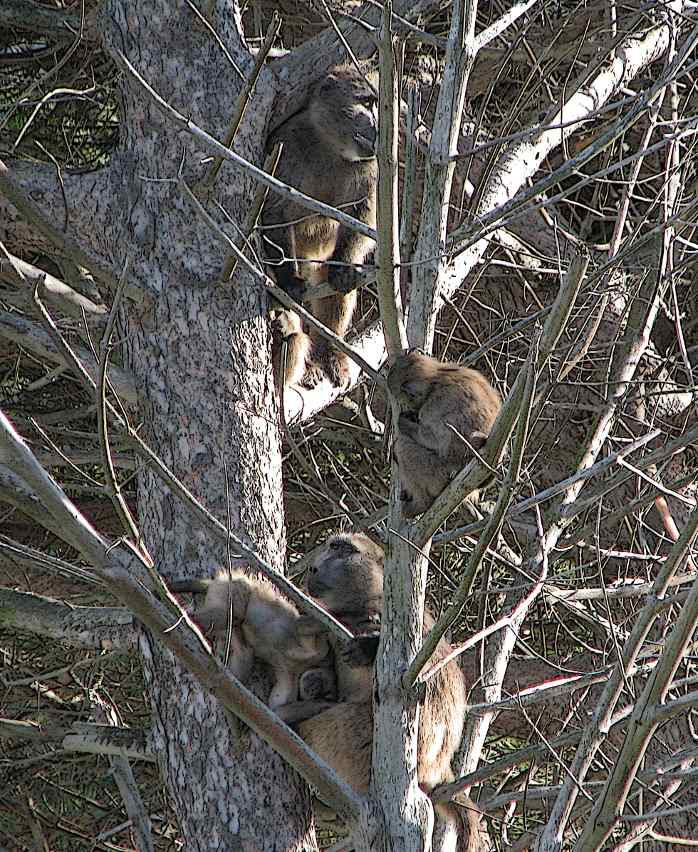
Four baboons in a tree shortly after waking up - one still looks a little tired.
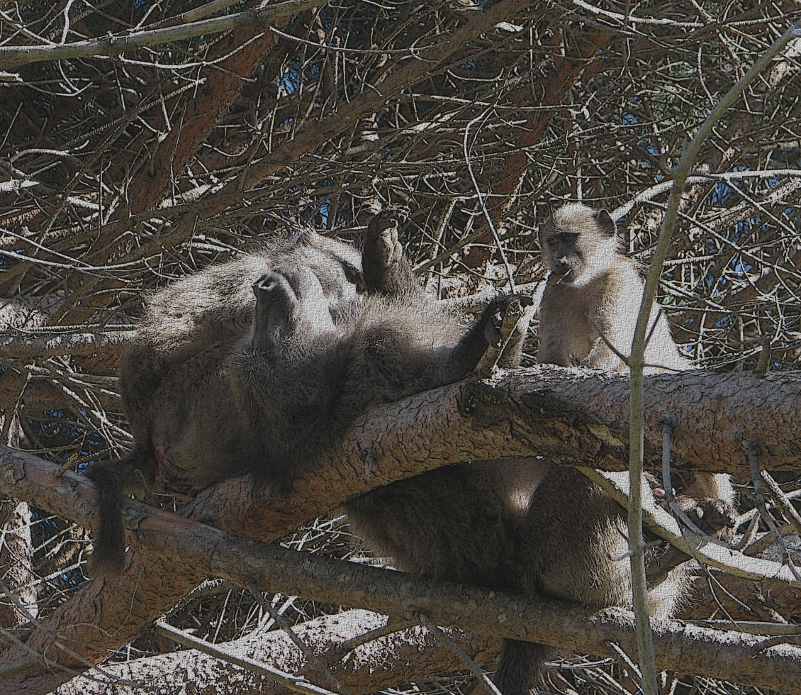
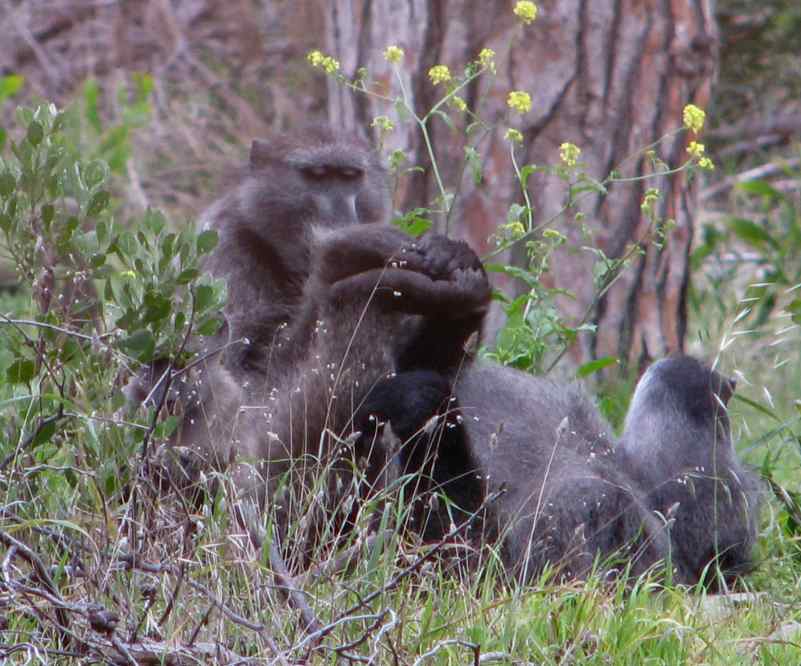
Alpha male puts his feet up while being groomed by a female. Both were startled by a sound resembling pellets being shot, something they hear and feel frequently in some residential areas. Many of the animals are riddled with pellets, a number have been shot, and some are amputees as a result of negative and intolerant human interaction including trapping.
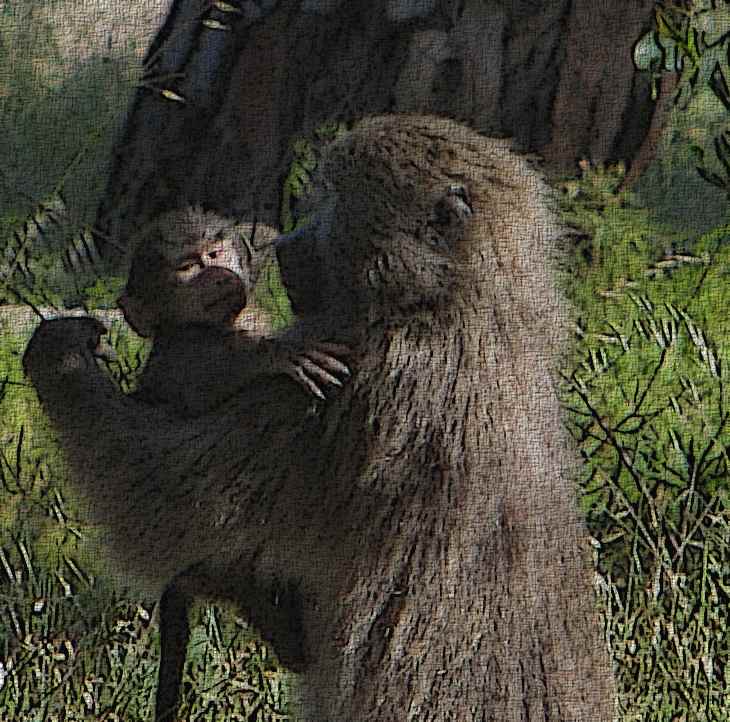
Baboon
holds a baby baboon. Black haired pink faced baby baboons receive
much attention from other troop members, but when older are not above
being disciplined by other troop members if misbehaving. The troop
operates according to a strict hierarchical structure. Males fight for
dominance to determine their ranking, while females inherit theirs from
their mother. Females generally stay with the troop all their lives,
while males may disperse or leave to join another troop or start their
own troop.

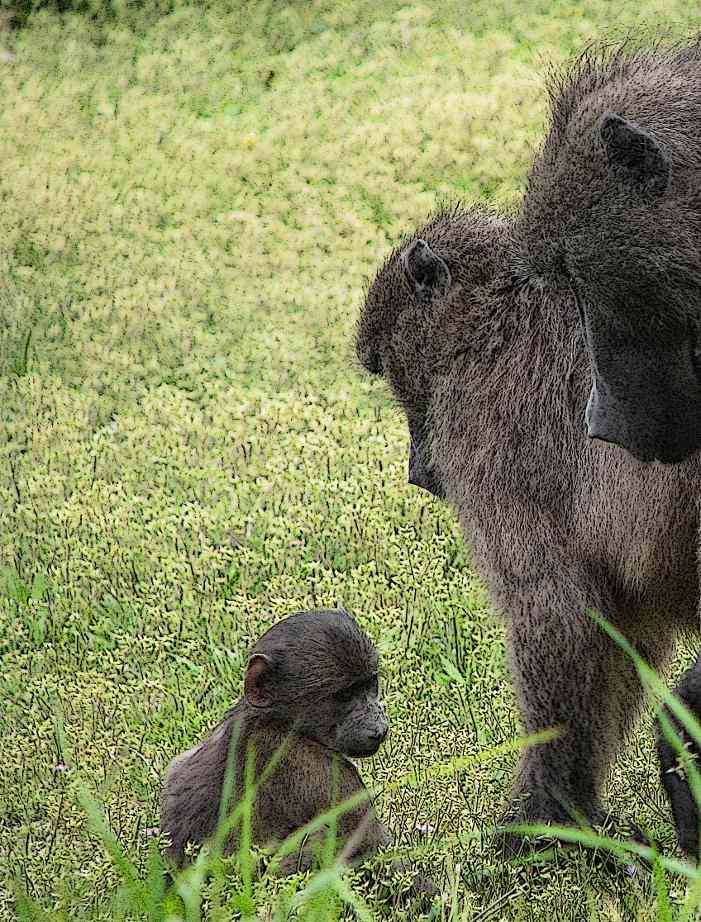
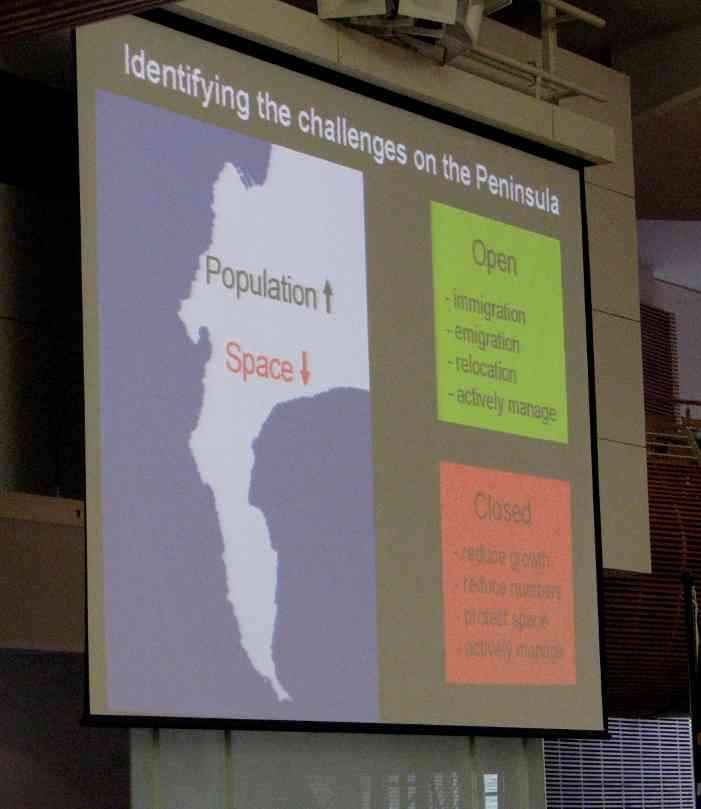
In July 2009, a 6 month interim management contract was awarded by a select panel of the Baboon Management Team or BMT a group of government and civic representatives (then chaired by CapeNature representative Natasha Wilson) to a new service provider amidst allegations of a flawed process. (The MD of the company, Dean Ferreira, was employed in previous years by another City administration to manage several nature reserves.)
Baboon Matters had successfully managed the
project for the last decade but was opposed to the culling requirement in the protocol and the contract.
In August, public concern increased when controversial management
strategies were made, including the protocol for culling of baboons, using scientific back up from BRU, a baboon
research unit that was being consulted by the City and CapeNature.
If the system of baboon management was defined as
"closed" where baboons are not moved off the
Peninsula, Dr O'Riain told the workshop this would require as an immediate priority reduction of
growth. He also said that reducing numbers would be inevitable and listed various categories that could be "selectively removed" i.e. culled.
Despite
all evidence to the contrary, including the latest tender for a
contract starting 1 February-30 June 2010, calling for quotes for
culling baboons, Dr O'Riain
and BRU deny the protocol is a "culling protocol" - a word he believes
causes "public hysteria". The protocol has indeed created public concern
around the world for the Peninsula's baboons.
BRU claims "the single most important step in the conservation and management of baboons on the Cape Peninsula" has been a digitised map presented to the City and Dept of Environmental Planning, showing baboon home ranges so they can be recognized when urban development is planned - yet if baboons are culled, including entire troops, this could simply serve as a record of where they once roamed before they were culled.
Ironically,
rather than helping their conservation, BRU's involvement with the preparation and endorsement of the "action plan
for dispersing males and repeat raiders" could be instead seen as putting the Peninsula baboons at great
risk.

Some of Dr O'Riain's controversial recommendations for active management of a "closed system" presented at the workshop included bear bangers and bull whips and experimental provisioning or feeding stations. The use of bullwhips - or horsewhips - long whips which make a loud cracking sound can be traumatic for the animals, subjecting them to further abuse and injury if the animals are actually touched. The implementation caused an outcry including raising objections from the CEO of the Cape of Good Hope SPCA. Additionally it sends a wrong message to residents that whips may be used on the baboons, some of whom have already done so.
BRU has used bulky collars on the animals in order to track them
and acquire data of the baboons' whereabouts including for data for
their maps. A number of the current recommendations are seen as
experimental in nature, rather than showing the proper concern for the
animals' physical and psychological welfare both in the short and long
term.

A presentation made in July by Dr O 'Riain stated that if the Peninsula baboon population is managed as a "closed population" then reducing growth is an immediate priority and reducing numbers inevitable. He asked "should fewer troops not be managed better with the limited resources?"
An
option on 4th capture of the protocol
for "dispersing males and/or repeat raiders" introduces "sanctuary"
as an alternative to culling. A sanctuary was proposed
several years ago by Julian Saunders, a BRU founder member to some
members of BRU. In October in a newspaper article, he suggested it as
the "obvious solution" to the Peninsula's baboon "problem".
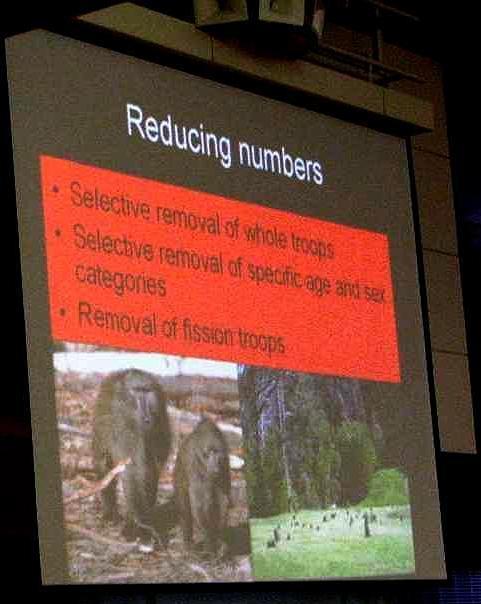
According
to Dr O'Riain's presentation, reduction of numbers includes selective
removal of whole troops, selective removal of specific age and sex
categories, and removal of fission troops. In August, the
extremely controversial protocol was prepared - an "action
plan for dispersing males and/or repeat raiders" - and hurriedly
passed despite objections by some members of the BMT, including Jenni
Trethowan of Baboon Matters who together with the SPCA, later
resigned from this body.
Trethowan was not included in the initial 4 meetings where this may have been discussed but on hearing about the 5th one, insisted on being present. Objections were called for by Dr O'Riain within 24 hours, hers were ignored and the action plan passed.
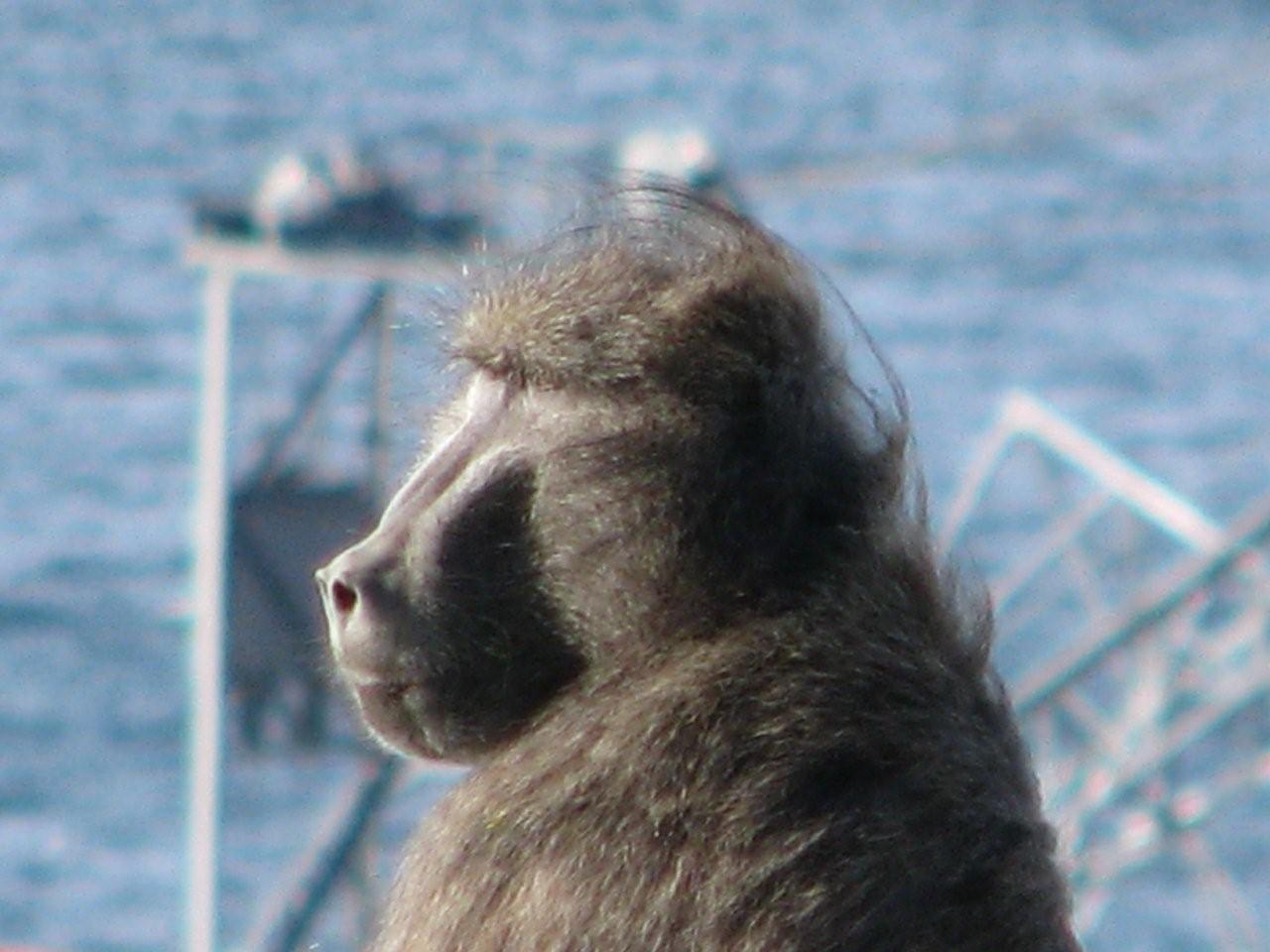
Bart the Baboon, acquired somewhat of a "folk hero" status in 2009. The first dispersing male to be targeted by the protocol, he continued to frequent the UCT campus, home of BRU, despite the death threat hanging over his head. Dr O'Riain gave his support to Bart's culling even though he described him as a "fantastic animal" and "no threat to anyone".
In
justifying his culling, he called Bart a "low quality male"
as he had lost some canines used in fighting (as have various
other males, including Alpha males.) He also claimed that Bart coming into the urban area
was a risk to other baboons outside the urban edge and could
transmit pathogens such as parasites from contact with humans. This
claim was backtracked on in November, with BRU saying that there is
currently no evidence of human to baboon transmission or vice versa
and they are still researching this matter. (This is yet another reason for
authorities to reconsider the validity of input given by BRU in support of culling of the baboons.)
Baboons
may
leave
their troop temporarily during fighting in male
hierarchical fights for dominance, they may leave to start their own
fission troop or may possibly leave to join another troop. The protocol
specifically targets dispersing male baboons. However, the repeat
raider clause could be used to target any baboon old enough to eat. (It
is of note that in his presentation at the workshop, Dr O'RIain referred
to various other categories of baboons that could be targeted for
removal including whole troops, age and gender categories.)
Media
focus has been on the dispersing male category, but the repeat raider
category affects a greater number of baboons and attempts to override
their current legally protected status, raising questions about its own
legality.
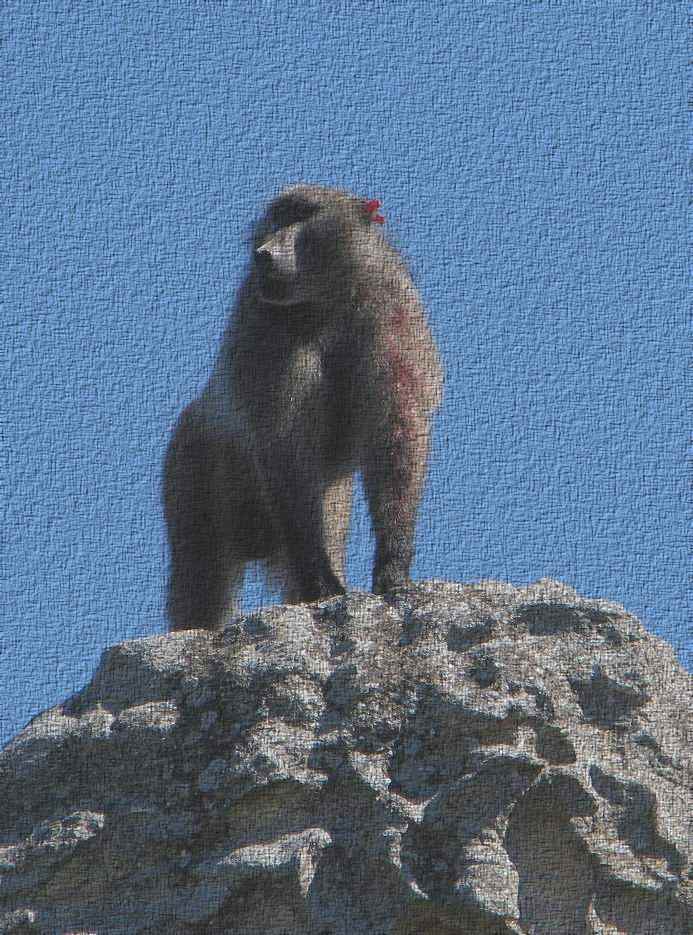
Anele, who together with Bart, Mike, Sol and others as so-called "dispersing males" was ear tagged in terms of the new protocol - putting them on death row. Options exist for killing the animals from the 2nd capture to the 4th and final capture. Male baboons are important in the troop structure (particularly in a free-ranging situation), protecting youngsters and females and keeping order in the troop.
Baboon monitors believe that Anele was killed in November, his features terribly mangled by the impact of a car. A number of breeding age baboons were killed during 2009, as a result of human interaction. Even without the culling protocol, their numbers are regularly reduced.
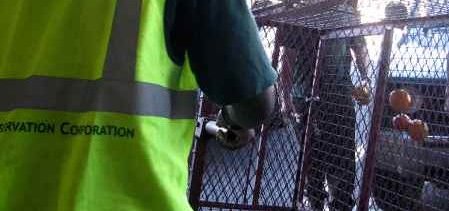
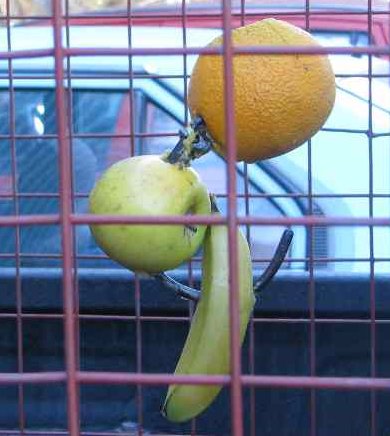
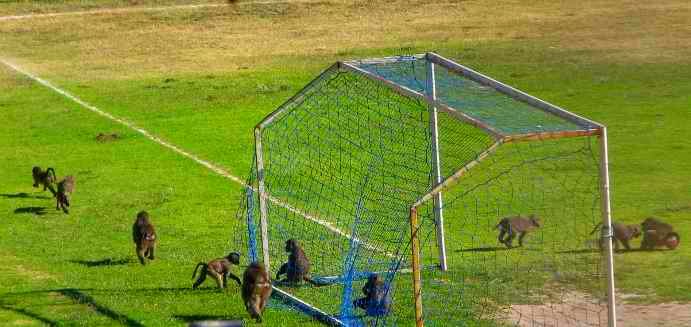
With months to go before the 2010 World Cup, baboons enjoy playing on a soccer field. However, it must be asked how many of Cape Town's free-ranging baboons will survive till the 2010 World Cup and beyond given the culling protocol or "Action plan for dispersing males and/or repeat raiders"?
A tender for a baboon monitoring management contract from 1 Feb-30 June called for quotes for the quantity for "removal, relocation and/or euthanizing of 4 dispersing males" per month, again raising concerns about the route baboon management has taken in 2009 with its emphasis on culling and for the future of the Peninsula troops. This contract was again awarded to Dean Ferreira's Nature Conservation Corporation. Objecting to the provision for culling baboons, Jenni Trethowan did not tender for the contract which closed in December.
Of note is that in 2002, after male baboons were killed by dogs and people were calling for baboon culling as they do currently. Ferreira as conservation manager for the City was quoted in an article in the Cape Argus opposing the killing of baboons. "Ferreira is adamant that killing baboons doesn't help. As a conservationist, I will not be involved in killing baboons. If we compromise on baboons, then where do we stop?"
While some are attempting to portray baboons as a threat to tourists' safety during the 2010 World Cup, similar allegations of baboons being "increasingly aggressive" were made earlier in the year regarding residents' safety in order to urge authorities' action and intervention. This occurred prior to the change of baboon management and the adoption of the controversial protocol now threatening the Peninsula's baboons with culling.

Who will protect Cape Town's Chacma baboons?
Since July 2009, the baboons are not only threatened by the actions of some residents, they are faced with new management and strategies using scientific back up criticized by other independent scientists, primatologists and experts. The most significant being a culling protocol biased against natural baboon behaviour and circumstances, at the same time in effect stripping baboons of their legally protected status.
An article was syndicated
worldwide in November 2009 quoting Dr O'Riain, head of BRU and a
Simonstown area resident who earlier in the year asked CapeNature if
baboons could be shot in self-defense, at the time claiming they no longer responded to the recommended humane method of
a jet of hose water in chasing them off a property. While that may have been her own experience, the statement is not true for other baboons.
At the time she was quoted in the media as saying one suggestion was to relocate or cull the "more aggressive males". She has subsequently actively supported removal of baboons from the Simonstown area, specifically the Smitswinkel troop, using whips and bear bangers.
The November article claims
baboons are "increasingly aggressive" and officials are
"battling to control" them using pictures of the
Smitswinkel troop including the Alpha male sitting in the back seat of
a car with a youngster eating a snack.
It promotes the idea that baboons could prove a threat to the safety of 2010 tourists - all of which claims are similar to those leading up to the baboon expert workshop shortly preceding management changes and strategies. It again gives the impression, however inaccurate, that there is a "siege situation" and the authorities urgently need to step in to sort out a potential threat to human safety and security - earlier in the year it was claimed on behalf of local residents, now for tourists.
While both residents and tourists must indeed take the security measures that prevent negative interaction with baboons such as securing properties in order to prevent baboons' access to food and potential conflict, and practical steps are needed to ensure this, while the Smitswinkel troop and other troops along the tourist routes need to be properly monitored to minimise potential negative interactions with tourists who do not realise that baboons should not be fed and should not be touched, being wild animals.
Effective signage and graphical representation understood by all languages along roads warning tourists not to display food, to close windows and lock car doors.
Claims or articles that seek to sensationalise baboon encounters are neither in the interests of the City, Cape Town's tourism industry nor of the baboons, an important part of that tourism.
When the resident made her claims earlier in the year, the protocol for culling baboons was not in place.
Now it has been adopted.
Since the second half of 2009, the already endangered Peninsula baboons have never been under greater threat.
With a tender issued for a new interim management contract starting 1 February-30 June 2010 asking for quotes for removing, relocating or euthanizing four dispersing males per month, how many Peninsula Chacma baboons will survive till the World Cup and beyond?
Who will protect Cape
Town's free- ranging Chacma baboons?
Photo of Bart courtesy Baboon Matters
All Content Copyright 2009-2010
All Rights reserved L Thomas
No portion of content may be reproduced in any way without written permission